Lecture: Painters And Posters (1850 – 1895)
The highlight of this week’s lecture was the comeback of craftsmanship in art and design. As a reaction of mass production in Industrial Revolution, artists, designers and architects like William Morris and Charles Robert Ashbee formed the Arts & Crafts movement under the basis to revive handcraft products and help under-appreciated craftspeople.
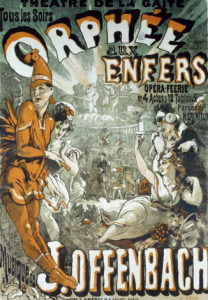
1879 – Jules Chéret – Orphée aux Enfers from Judy’s lecture
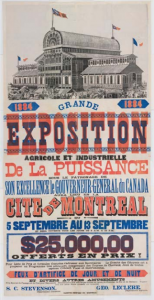
1884 – Great Exhibition of Strength in Agriculture and Industry, Montreal from Judy’s lecture
In the side-by-side comparison of the “Arts & Crafts movement inspired” poster and the type Canadian poster, we begin to have an idea of the movement influence on Britain in the late 19th century. While the Rococo influenced Canadian poster features overly decorative types almost jumping right on your face, the one on the left uses dynamic shapes and harmonious colour palette (red and yellow was the emphasis and blue and faded pink as backdrop). The female figure overlapping the title was also an interesting and eye-catchy element that really ties the text and imagery together. Arts and Crafts movement was undoubtedly an impactful movement that concerns public about the qualities and origins of products.
Research: Clothing of Victorian Fashion (1850 – 1900)
The Victorian era was known for speedy change in fashion trends. Before a certain style was even familiar to the public, a new set of clothing was already on its way! As you might already know, the history of the Victorian fashion falls back to Queen Victoria’s reign from 1837 to 1901. Under the time of economic growth and technological advance, Upper and middle class began to invest in trends developed under the British culture. In this week’s research section, we will be diving into a more in-depth study on female clothing trends from 1850s-1890s.
Mid Victorian Era
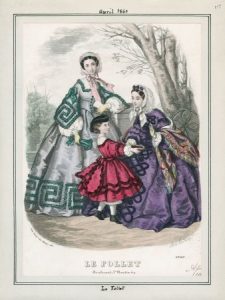
“Greek Key” patterns on skirts
In the 1850s, a structured petticoat called crinoline was developed to help the bell-shaped skirts stay in shape and not floppy. The overall 50s trend consists of wide pagoda sleeves, ruffled skirts with plaid or floral patterns. The waist shape of the gown usually dropped below the actual waistline with the front appear to be longer. White sleeves were also worn underneath the pagoda sleeves to create puffier illusion.
1860s was the time where trend shifted from puffy skirts to more comfortable flat skirt. The waist shape also started to go above natural waist level instead. The general motifs were buttoned bodice and solid colours with geometric trimming. One of the most common pattern on skirt is the “greek key” design. In the daytime, dresses had high neckline with lace or tatted collar; whereas in nighttime, women wear gowns with low neckline and short sleeves with modest gloves.
Transitional Period

Types of Petticoats in Victorian Fashion
The transitional period in the mid-1860s (1865-1867) introduced crinolettes and bustles. In replacement of crinolines, crinolettes and bustles were new petticoats that drastically increased volume at the back.
As a magnified version of crinolettes in accentuating butts, the trapezoidal-shaped bustles became hugely popular in the 1870s. Inspired by the 18th century’s fashion, the big hair and extravagant decorations (like frills, flowers, laces, pink and pastels) made a comeback during this period. For decoration, women would also wear a layer of underskirt as well as an overskirt on top of the skirt. Within 70s, tea gowns were also introduced for casual wear or at-home events.
Natural Form Era
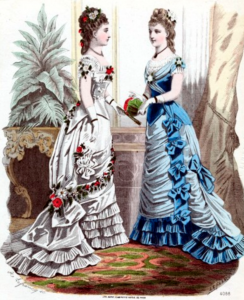
Natural Form Era dress code
In 1878, however, the Natural Form Era took over the heavy wire-framed bustles trend as trends moved to flat skirts with the more comfortable small bum pads instead. The tight-fitted bodices shifted to being long and smooth fitting over the hips. Bodice and skirt in one dress without a waist seam was also popular as well. In sum, the focus of this period was asymmetry with vertical flows!
Late Victorian Era
This trend lasted until 1882 and eventually, the bustles were back to the mainstream again! The 1880s bustles, however, were not trapezoidal-shaped anymore and they were just a little wider than the natural hip shapes. Instead of having a 45 degree bustle shape going down, the bustles now formed a 90 degree shelf or rather “bump” on women’s back hips. Other than bustles, the spoon busked corsets that give the illusion of full belly also became trendy. The 80s embraces minimalism, geometry and earthly tones (Yet, another comeback! this time is from 1830s).
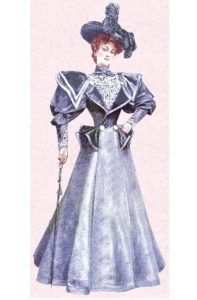
Power Dressing in Victorian Era
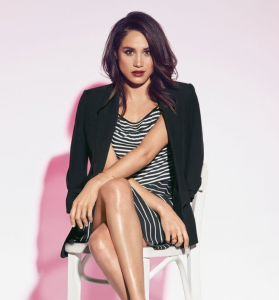
Power Dressing today
With the never-ending cycle of trends on the skirts, the focus in the 1890s shifted to sleeves. From 1890-1895, the sleeves got puffier and bigger. It is also interesting to note that in the 90s, Late Victorian women started to embrace sharp tailored jacket and the shoulder pads fashion that made them appear confident, strong and “masculine”. With the advocate of gender equality at the time, power dressing and utility clothing formed to show women strength in corporate workplace. The bustle trend faded with the trend of pleats running down to the back of the garment. Although the power dressings have evolved, the concept still remains popular these days to show female strength.
Reference:
http://www.victorian-era.org/late-victorian-fashion-women-men-girls-boys.html
https://www.youtube.com/watch?v=2VSz5G_qeS8&t=339s
http://trulyvictorian.net/history/1877.html
http://www.fashion-era.com/mid-late_victorian_fashion.htm
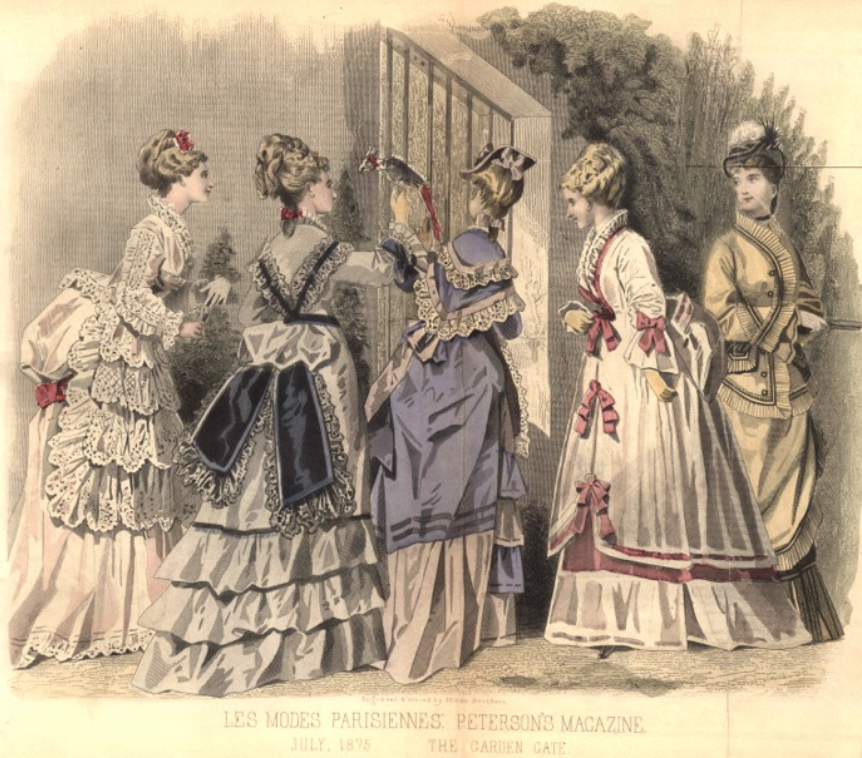
Leave a Reply
You must be logged in to post a comment.